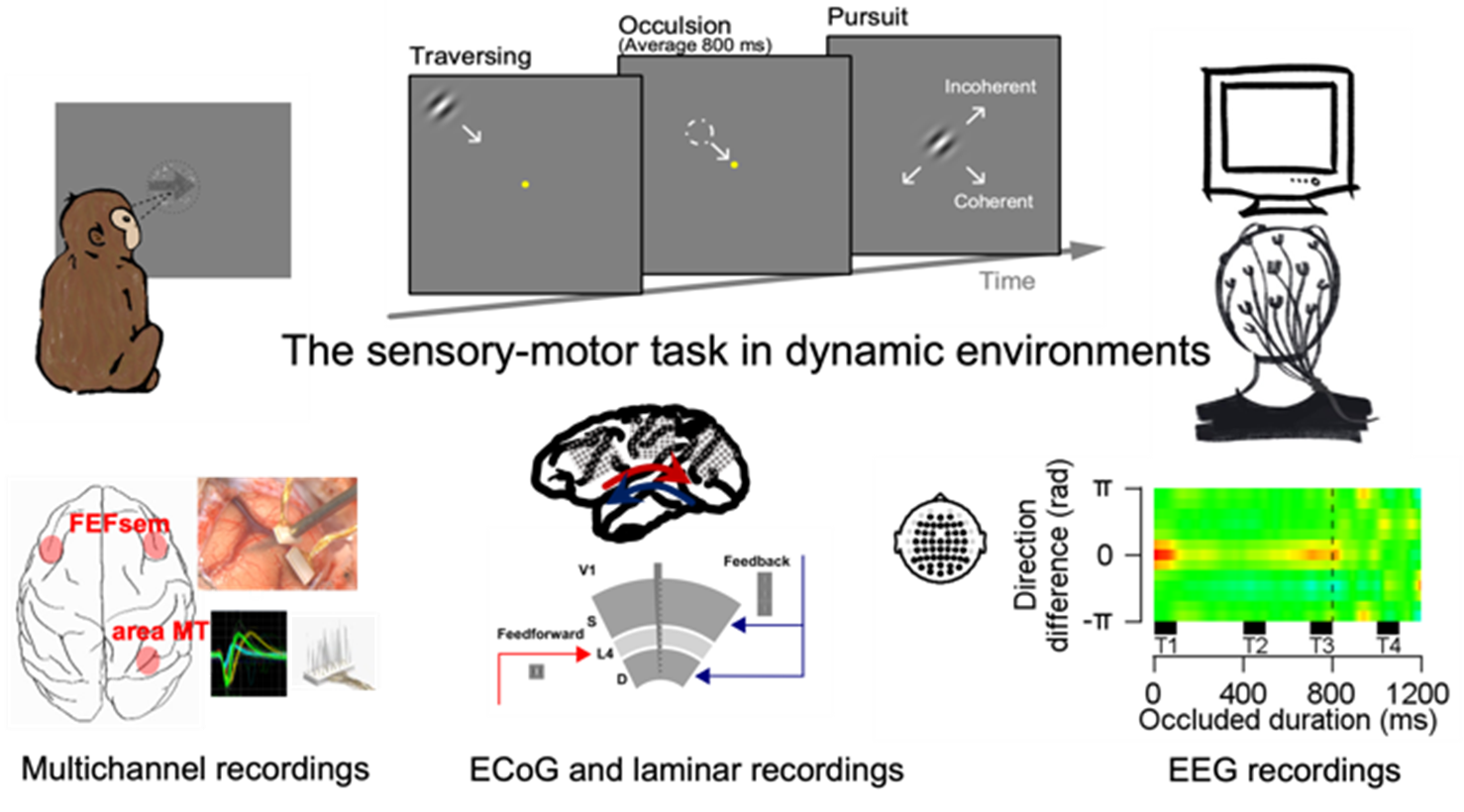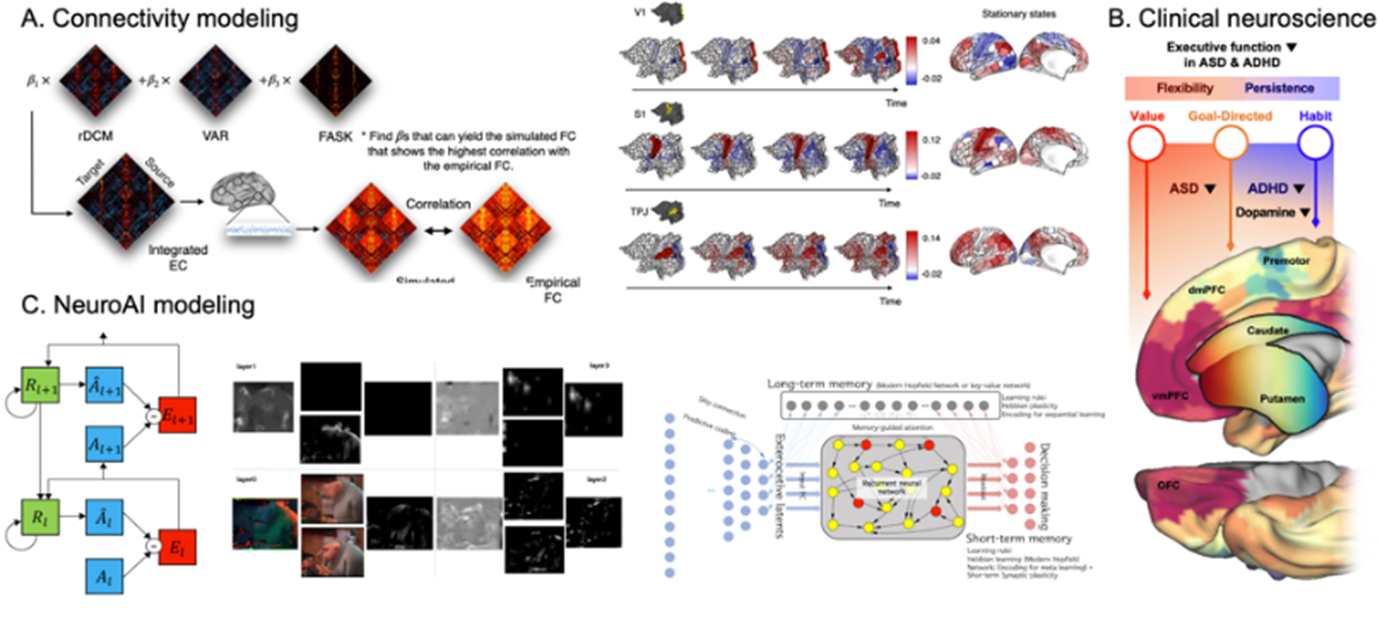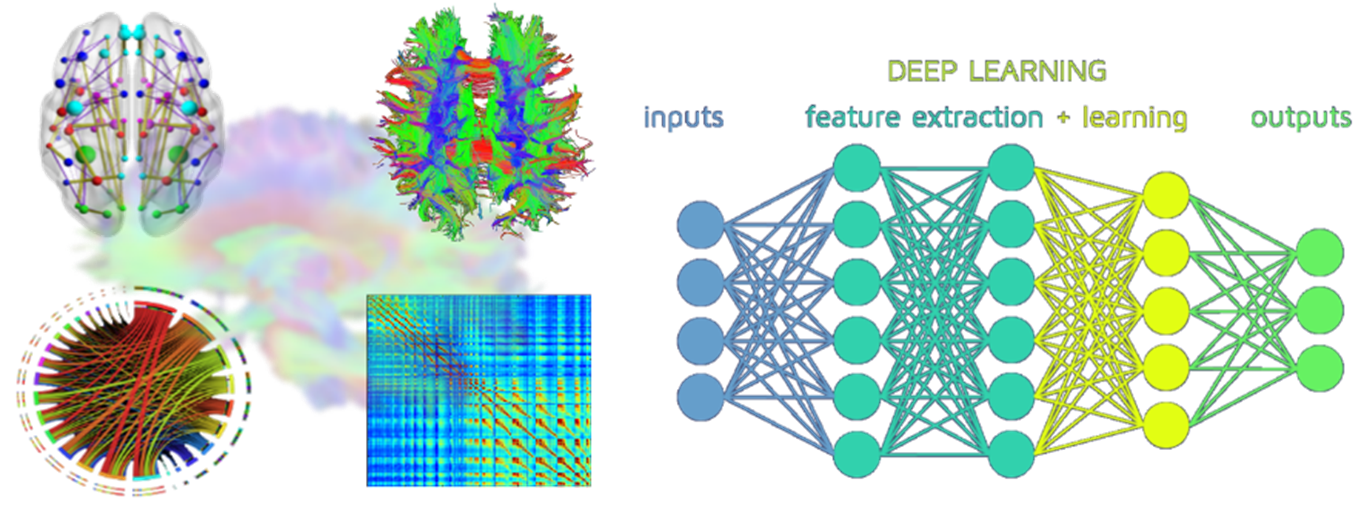Computational Neuroscience Team
Understanding human brain functions requires multiple levels of mechanistic explanations underlying their biological substrates. Computational Neuroscience Team seeks to unveil integrated and fundamental principles for core brain computations that are involved in the cognitive functions of healthy and diseased brains. We tackle this question with multi-species and multi-level approaches, from single-cell level cellular network mechanisms to whole-brain level connectivity and cortical hierarchy, using electrophysiology, neuroimaging, in-silico simulations, and imaging biomarker development using machine learning. We put an extra emphasis on understanding the neural computation behind the probabilistic inference, learning and action of human and animal, through which we also aim at providing a principled understanding of various symptoms in atypical brain conditions such as autism spectrum disorders.
(1) Perception in Action (PI: Joonyeol Lee)

The Perception in Action unit is dedicated to understanding how our brain processes sensory information and translates it into motor commands, especially in dynamic environments where our survival depends on quick and precise responses. The brain accomplishes this task through the integration of both bottom-up sensory information and top-down cognitive factors. The unit uses various techniques such as multichannel recordings and EEG in both humans and non-human primates to investigate how the brain processes and integrates this information. Moreover, by utilizing multi-areal ECoG with layer-dependent recordings, the unit studies how different regions of the brain interact with one another to achieve this feat. This research has significant implications for our ability to adapt to changing environments.
(2) Computation abd Cognition (PI: Hansem Sohn)

With the integrative experimental approach, we aim to tackle the question of how the brain processes numerical information in a compositional manner. To achieve this, we will design number-estimation and decomposition tasks using artificial and naturalistic visual stimuli and examine the behaviors of human and non-human primates. Additionally, we train artificial neural network models on the number-related task to test their predictions on neural dynamics at both single-unit and population level. Together, this project will contribute to a deeper computational understanding of numerical cognition across multiple levels of analysis.
(3) Network Neuroscience (PI: Seok-Jun Hong)

The “Network Neuroscience Unit” aims to uncover various organizational principles of functional and structural brains as well as information flow dynamics across the networks in human. These principles allow the Unit to learn the mechanisms of how the high-order cognitive functions emerge in a self-organizing fashion and biological substrates that are useful to devise new inference and learning algorithms in artificial intelligence. Our research program consists of three main pillars: i) computational brain imaging, ii) clinical neuroscience, and iii) NeuroAI modeling. They are complementary, in a sense that we are using the brain imaging tools to identify new governing rules for brain network formation and to model their dynamics, transfer these techniques and knowledge to dig into hidden pathological substrates in various developmental psychiatric conditions, and finally study biologically meaningful AI algorithms inspired by core brain-working mechanisms.
(4) Machine Learning (PI: Hyunjin Park)

It is critical to understand brain structures, functions, networks, and behaviors through integrative system neuroscience driven by high-tech neuroimaging tools. With ever-increasing data, handling large-scale data to extract biologically-relevant information is an important neuroscience issue. Machine learning has become a key component in neuroimaging analysis and the trend is likely to continue in the future. Powerful yet highly flexible machine learning algorithms, such as deep learning, are becoming the new norm in neuroimaging studies.
The unit aims to develop algorithms to support advanced neuroimaging analysis by conducting the following projects. 1) Developing sample-efficient methods; Leveraging recent advancements in unsupervised contrastive learning, we plan to pretrain a generic fMRI decoding model from large-scale public databases and fine-tune the model with local data. 2) Developing interpretable models; We aim to adapt interpretable deep learning algorithms from computer vision to neuroimaging and validate the interpretation using expertise in vision and pain within CNIR. 3) Developing reliable biomarkers; Neuroimaging analysis often leads to imaging models that can provide reliable and quantifiable information for normal and diseased brains. We aim to develop robust and generalizable fMRI-based biomarkers for mental functions and health-related outcomes. 4) Developing deep learning-based preprocessing methods; All neuroimaging data undergo multiple preprocessing steps before they can be used to extract useful features. We aim to integrate and validate deep learning approaches into the neuroimaging data pipeline for both human and non-human data.
SELECTED PUBLICATIONS
1. Frontal-to-Visual Information Flow Explains Predictive Motion Tracking, Son S. et al. (2023), NeuroImage, 269, 119914
2. A shifting role of thalamocortical connectivity in the emergence of large-scale functional brain organization during early lifespan, Park S.W. et al. (2023), Preprint
3. Diagnosis-informed connectivity subtyping discovers subgroups of autism with reproducible symptom profiles, Choi H.S. et al. (2022), NeuroImage, 256, 119212
4. Enhanced neuroimaging genetics using multi-view non-negative matrix factorization with sparsity and prior knowledge, Won J.H. et al. (2022), Med Image Anal, 77, 102378
5. Validating model-based Bayesian integration using prior–cost metamers, Sohn H. et al. (2021), Proc Natl Acad Sci USA, 118, e2021531118

